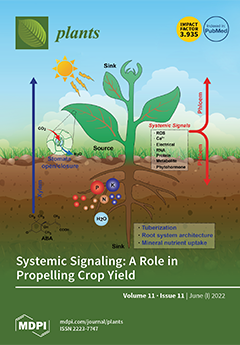Metallothioneins (MTs) are polypeptide-encoded genes involved in plant growth, development, seed formation, and diverse stress response. High temperature and humidity stress (HTH) reduce seed development and maturity of the field-grown soybean, which also leads to seed pre-harvest deterioration. However, the function of MTs
[...] Read more.
Metallothioneins (MTs) are polypeptide-encoded genes involved in plant growth, development, seed formation, and diverse stress response. High temperature and humidity stress (HTH) reduce seed development and maturity of the field-grown soybean, which also leads to seed pre-harvest deterioration. However, the function of MTs in higher plants is still largely unknown. Herein, we isolated and characterized the soybean metallothionein II gene. The full-length fragment is 255 bp and encodes 85 amino acids and contains the HD domain and the
N-terminal non-conservative region. The subcellular location of the GmMT-II-GFP fusion protein was clearly located in the nucleus, cytoplasm, and cell membrane. The highest expression of the
GmMT-II gene was observed in seeds both of the soybean Xiangdou No. 3 and Ningzhen No. 1 cultivars, as compared to other plant tissues. Similarly, gene expression was higher 45 days after flowering followed by 30, 40, and 35 days. Furthermore, the
GmMT-II transcript levels were significantly higher at 96 and 12 h in the cultivars Xiangdou No. 3 and Ningzhen No. 1 under HTH stress, respectively. In addition, it was found that when the Gm1-MMP protein was deleted, the
GmMT-II could bind to the propeptide region of the Gm1-MMP, but not to the signal peptide region or the catalytic region.
GmMT-II overexpression in transgenic
Arabidopsis increased seed germination and germination rate under HTH conditions, conferring enhanced resistance to HTH stress.
GmMT-II overexpressing plants suffered less oxidative damage under HTH stress, as reflected by lower MDA and H
2O
2 content and ROS production than WT plants. In addition, the activity of antioxidant enzymes namely SOD, CAT, and POD was significantly higher in all transgenic
Arabidopsis lines under HTH stress compared wild-tpye plants. Our results suggested that
GmMT-II is related to growth and development and confers enhanced HTH stress tolerance in plants by reduction of oxidative molecules through activation of antioxidant activities. These findings will be helpful for us in further understanding of the biological functions of MT-II in plants.
Full article






